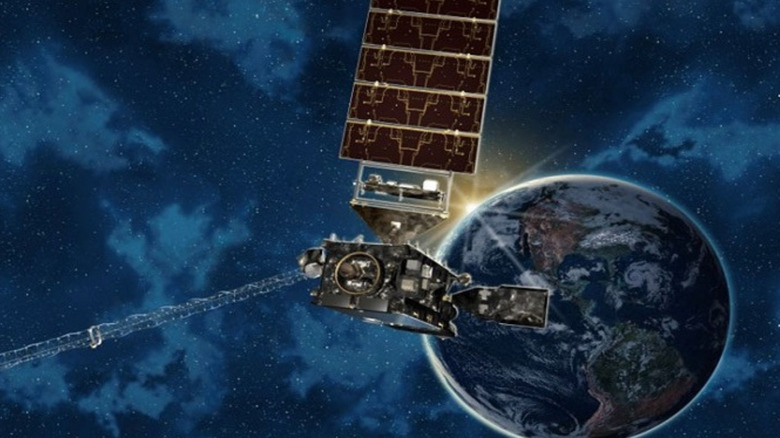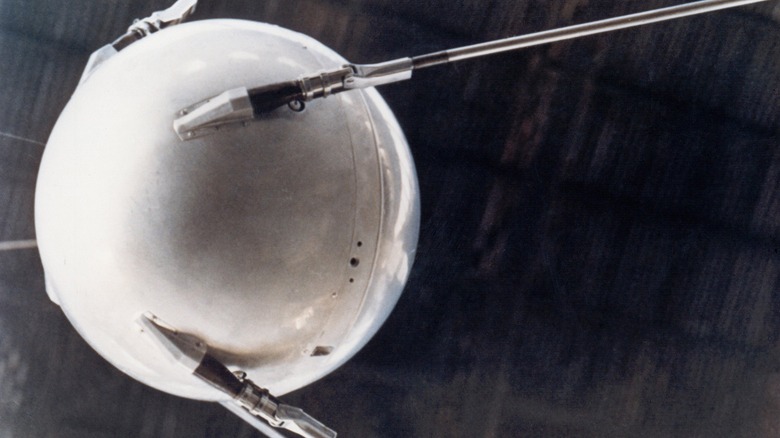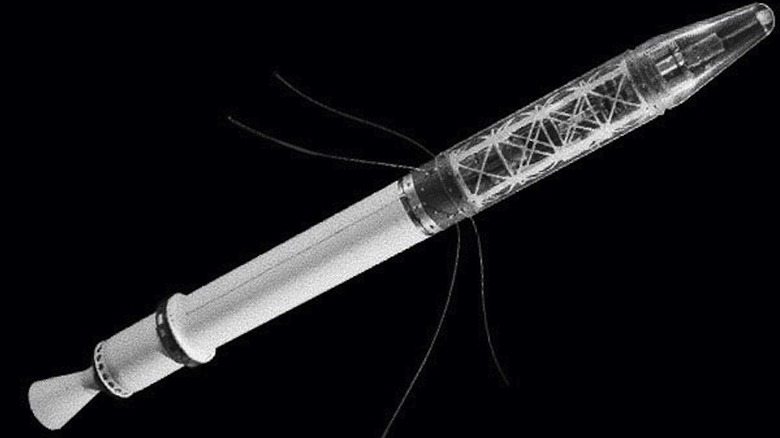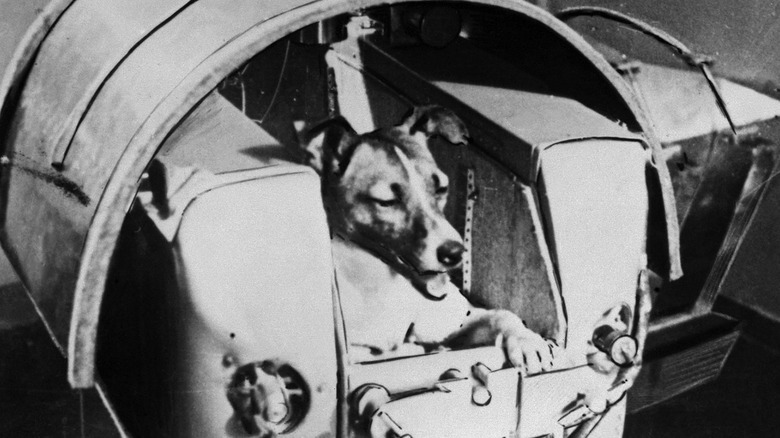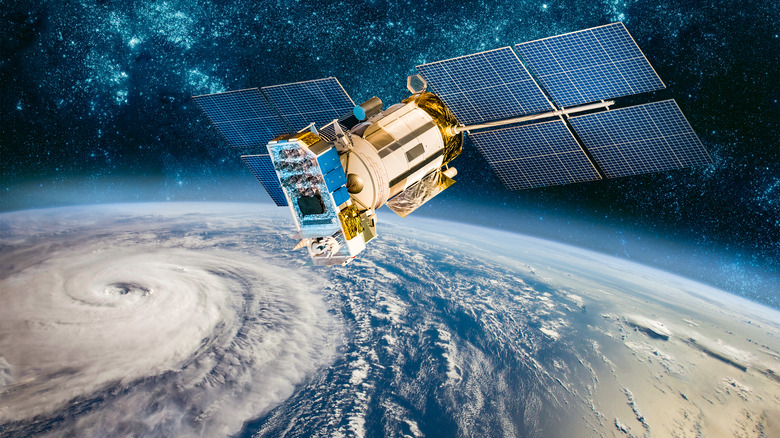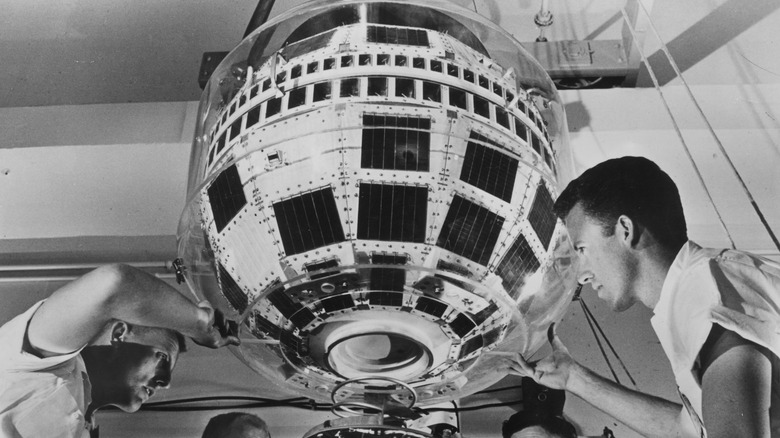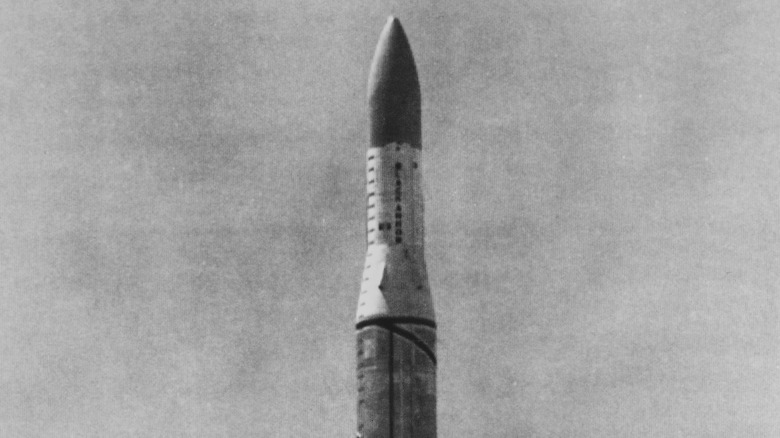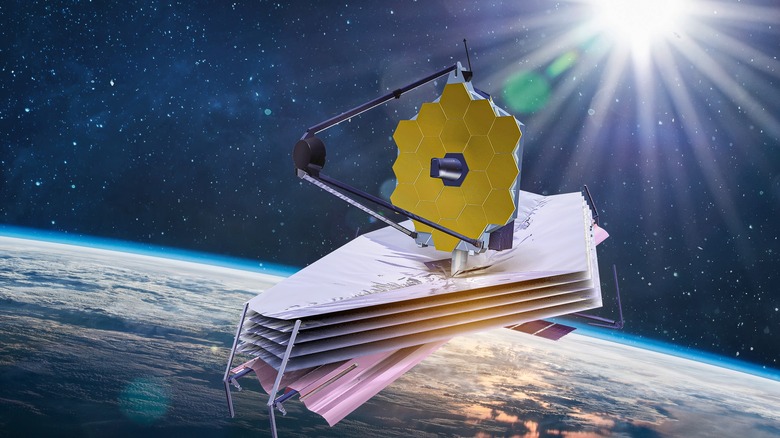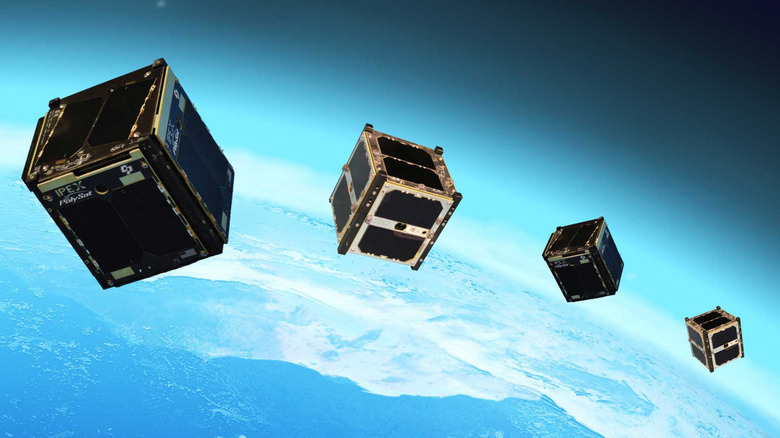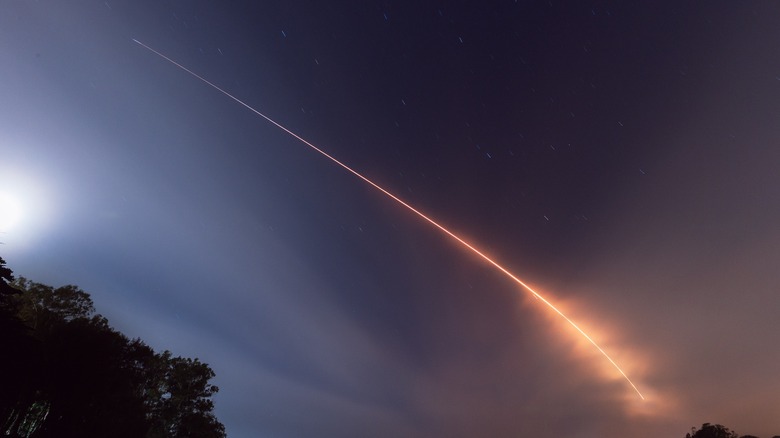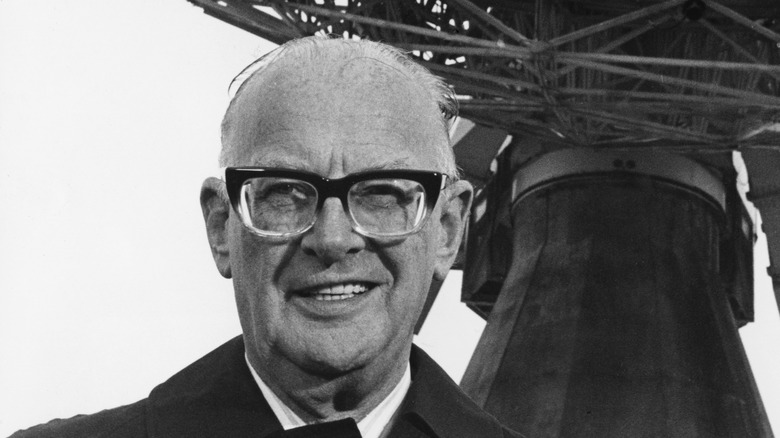The History Of Satellites Explained
Ever since humanity first began to theorize about the nature of space and our planet's place within it we have dreamed of placing objects in the heavens looping the planet, even when we believed it incorrectly to be the center of the Universe. Around 1610, German astronomer Johannes Kepler first used the term "satellite" — a Latin word meaning "one who escorts or follows after an important person" — to describe the moons orbiting Jupiter.
Kepler's laws of motion would, alongside Newton's laws developed towards the end of the 1600s, become a crucial element of placing satellites in orbit and keeping them there. Before satellites became a scientific reality, they were immortalized in science fiction, first depicted in The Brick Moon by Edward Everett Hale in 1869, and ten years later in Jules Verne's The Begum's Fortune.
By the early twentieth century, scientists would begin to calculate possible stable orbits around Earth and even begin to design space stations that could occupy such orbits. Other notables like Arthur C. Clarke would also plant the seed of geostationary satellites that could communicate around the world and broadcast radio or television shows. Finally, before the sixth decade of the 20th century rolled around, the first satellite would enter orbit, marking the moment a scientific dream became a reality.
But, could those pioneers even guess how ubiquitous and important satellites would become?
What is a satellite and how do they stay in orbit?
Satellites can sit in different orbits around the Earth depending on what their function is.
Geostationary (GEO) satellites orbit Earth at an altitude of 22,236 miles and rotate at the same rate as the planet locked to its equator. Low-earth orbit (LEO) satellites, on the other hand, orbit at an altitude of between around 100 miles and 620 miles.
These satellites have a bit more freedom in the path they take around the planet, but can spend time over unoccupied areas like deserts or oceans, so communications roles are reserved for satellites in GEO orbits.
One of the key aspects of placing a satellite into space is knowing it will stay there in orbit around the planet. As mentioned above, the theories that underlie this were formulated as early as the 1600s in the work of Kepler and Newton.
The National Environment Satellite Data and Information Service (NOAA) satellite stays in orbit by achieving a perfect balance between velocity and the gravitational pull that our planet exerts on it.
The closer to Earth a satellite orbits, the more rapidly it has to move to stay one step ahead of this gravitational pull. According to the European Space Agency (ESA), LEO satellites orbit at a speed of around 7.8 km per second — taking about 90 minutes to fully circle Earth.
Most satellites carry fuel, but this is not used to maintain orbital speed, instead, it's required when a satellite needs to change position, move to a higher orbit, or even perform evasive actions.
Sputnik 1: The first artificial satellite
The first artificial satellite, Sputnik 1, was launched from Baikonur Cosmodrome at Tyuratam, Kazakhstan — which was at the time part of the Soviet Union — on October 4, 1957.
The Russian satellite — with a name that means "companion" — was the first in a series of four satellites launched as part of the Sputnik program. An aluminum sphere with a diameter of 58 centimeters, Sputnik 1 had four whip-like antennas between 2.4 meters and 2.9 meters long, which almost resembled "whiskers" from one side of the craft.
One of the main roles of Sputnik 1 was to collect data regarding the density of the upper layers of the atmosphere and how radio signals travel through the ionosphere — the ionized part of Earth's upper atmosphere.
The craft was capable of detecting meteoroids but failed to spot any in the three weeks of operation before its satellite transmitters stopped operations after its onboard chemical batteries failed.
After completing around 1,400 orbits of Earth over 92 days, Sputnik 1 dropped out of orbit from an altitude of around 600 miles above the planet, breaking apart during its descent.
Explorer 1: NASA enters the satellite race
A few months after the successful launch of Sputnik, on the last day of January 1958, the United States would place its own satellite in orbit.
NASA's Jet Propulsion Laboratory (JPL) at the California Institute of Technology (Caltech) built the craft — designated Explorer 1 — which led to James Van Allen's discovery of radiation belts around Earth held in place by the planet's magnetic field.
On its website, JPL describes the launch of this satellite, Explorer 1. It writes: "A quick response to the Soviet Union's launch of Sputnik 1, Explorer 1's success marked the beginning of the U.S. Space Age." Its cosmic ray detector, provided by Van Allen made Explorer 1 the first satellite to carry science instruments into orbit.
Explorer 1 revolved around Earth in a looping orbit between 220 miles to 1,563 miles above Earth. The 203 cm long and 16 cm wide craft made an orbit every 114.8 minutes and a total of just over 12 and a half orbits per day. NASA says Explorer 1 made its final transmission on May 23, 1958. Almost 12 years later on March 31, 1970, the craft entered Earth's atmosphere following over 58,000 orbits of the planet.
The Explorer and Sputnik programs explode
In November 1957, Russia launched Sputnik 2 carrying Laika — a stray dog found on the streets of Moscow — who would become the first living thing to journey to space. The dog died in orbit after just a few hours, not considered a failure as there were no plans to recover her.
Sputnik 3 would launch in May 1958, carrying 12 instruments into the upper atmosphere. This was originally planned for the first Sputnik mission, but its size and complexity delayed its launch and led to the launch of the simpler Sputnik 1 first.
Like Sputnik 1, Explorer 1 set the stage for more satellite missions, with great success after initial setbacks. On March 5, 1958, an attempt was made to launch Explorer 2 into orbit, but the fourth stage of the Jupiter C rocket carrying it failed to ignite leading to the mission being scrubbed. And while Explorer 3 and 4 would also launch successfully, in March and July of 1958, respectively, Explorer 5 would also fail after the rocket's booster collided with its second stage.
The Explorer series of missions would become the longest-running series of spacecraft going on to consist of 73 satellites launched over a period of about 15 years. Of these, only four would fail and five would go on to operate for over ten years, with the longest-serving Explorer craft, IMP 8 retiring in 2001 after 28 years of operations.
Observing Earth's weather from space
One of the most common and important jobs for satellites is the monitoring of Earth's weather. While the first weather imaging satellite entered the planning stages in 1946, it would take 14 years to implement. On April 1, 1960, NASA launched TIROS-1 (Television Infrared Observation Satellite). TIROS was the first weather satellite to be designed by NASA but was beaten to orbit by Vanguard 2 — which launched on February 17, 1959, as part of the U.S Navy's Project Vanguard.
Not only did Vanguard 2 mean that the U.S. had a weather satellite before Russia, but the craft also remains in orbit to this day and is expected to remain around Earth for as long as 300 years. Vanguard 2's primary mission was to observe cloud cover on Earth from space. The mission of TIROS was to test the feasibility of weather satellites and to try out experimental television techniques designed to develop a worldwide meteorological satellite information system.
TIROS-I would not have the longevity of Vanguard 2, reaming operational for only 78 days. Yet in this period the craft was able to prove that satellites could be useful tools for surveying global weather conditions from space.
Information and entertainment in the space age
The landscape of our entertainment industry would be completely different today if not for satellites, as would the way we communicate information across the globe. As mentioned above, speculation about the use of satellites to transmit information began at least a decade before the first artificial satellite had made it to orbit. It would take until 1962 for the space age of communication to begin.
On July 10 of that year, Telstar 1 developed by the American Telephone and Telegraph Company (AT&T), was the world's first active communications satellite to be launched. Shortly after the launch the white spherical spacecraft with an exterior covered with solar cells, linked the U.S. and France thus facilitating the first transatlantic television transmission. Unfortunately, Telstar wouldn't remain in operation for long. In November of the same year, as it launched, radiation from the Van Allen belt fried its electronics. This led to its deactivation in February of 1963.
Satellites go global: Other countries enter the space race
Of course, the U.S. and Russia weren't the only countries to get involved in the new space age. France and Japan would be the first two countries to launch satellites outside of the superpowers in 1965 and 1970, respectively. Also in 1970, China would become the fifth country to launch a satellite when it blasted Dongfanghong 1 into Earth orbit on its Long March rocket. The United Kingdom launched its first satellite, the Prospero, in 1971 from Woomera, Australia, atop a Black Arrow rocket.
International collaboration became a key part of satellite launches in 1979 when the European Space Agency (ESA) launched Ariane-1 carrying two telecommunications satellites. Without this international collaboration, it would have been impossible to launch what is arguably humanity's most ambitious satellite — the International Space Station (ISS). The ISS — a collaboration involving Russia, the USA, the European Union, Japan, and Canada — would launch in 1998. It remains in operation to this day.
Studying the Universe Satellites and Space Telescopes
Not all of the satellites around Earth are directed inwards at our planet. Some have their views turned outwards toward the wider Universe. The first operational space telescopes were the American Orbiting Astronomical Observatory, OAO-2 launched in 1968, and the Soviet Orion 1 ultraviolet telescope aboard space station Salyut 1 in 1971.
These weren't the first space telescopes to enter planning, however. Perhaps the most significant space telescope to date has been the Hubble Space Telescope, which was first conceived in the 1940s. It would take almost five decades to bring Hubble to launch with it finally journeying to orbit in April 1990. But, even before Hubble launched, the next significant space telescope had already entered its planning stage.
In 1974, plans began for a project called the Large Space Telescope. Launched in December 2021 and renamed the James Webb Space Telescope (JWST), it represents perhaps the ultimate expression of a satellite designed to observe the Universe. With its massive 6.5-meter-diameter primary mirror the JWST will see further than Hubble, observing the universe in infrared light. This will enable it to see light from galaxies in the early universe, formed 13.5 billion years ago. This will not just give researchers an idea of how the Universe has evolved over its 13.8 billion-year-old lifetime but could help solve the mysteries of dark matter and dark energy. In addition to this, by studying planets outside the solar system — extrasolar planets or exoplanets — selected by another satellite, CHEOPS (CHaracterising Exoplanet Satellite), the JWST will study the atmospheres of other worlds. potentially discovering life elsewhere in the Universe.
Nanosatellites and CubeSats? Satellites get small
Since the 1950s, technology has gotten smaller and smaller so it's little wonder that satellites have also been undergoing miniaturization. This has led to the development of nanosatellites. Nanosatellites are defined as any satellite weighing less than 10 kilograms. Their small size enables them to be used as part of a larger grouping of satellites called a constellation. Nanosatellites can be fairly cost-effective to create as many of them are designed to make use of off-the-shelf components rather than relying on specially manufactured parts. This also allows the technology behind nanosatellites to be more frequently updated than other satellites.
One particular class of nanosatellites is CubeSats built to standard dimensions (Units or "U") of 10 x 10 x 10 cm — a little larger than a standard Rubik's cube — ranging from 1U to 6U in size and weighing less than 1.33 kg (3 lbs) per U. These make for tiny payloads that can be carried in their multitudes by rockets squeezing into additional space making for low-cost launches. The ESA explains: "They are packed in a container which, at the push of a button, ejects them into space via a spring system. A similar technique is used to deploy CubeSats from the International Space Station (ISS), where they are launched out of the Japanese module, Kibo."
Some of the uses include technology demonstrations, scientific studies, and even commercial purposes providing low-cost space access for research institutes and small businesses.
Satellite Internet: What is Starlink?
Space X is one of the companies taking advantage of small, low-cost satellites. Using a constellation of devices, Elon Musk's company is intending to provide high-speed global internet via a system called Starlink. As of January 2022, there were over 2,000 Starlink satellites in low-Earth orbit, with Space X planning to ultimately launch as many as 30,000 of the devices. The main benefits of the internet provided by Starlink are expected to be felt in rural and remote areas of the globe currently poorly serviced in terms of internet access.
Yet, not everyone is a fan of Musk's space-based internet project. In a paper published in February 2020, many astronomers pointed out that Starlink would have a significant impact on astronomical observations conducted from the surface of Earth. The impact on professional ground observations of space, the authors say, depends on the altitude and surface reflectivity of the satellites. The paper also highlights a growing concern regarding how crowded space is becoming around Earth.
Crowded Skies: Satellites today
As humanity becomes increasingly dependent on satellite technology, the questions of what impacts this is having on our view of space and just how many devices Earth can sustain, become even more pressing. According to the Union of Concerned Scientists (UCS) as of January 2022, there were 4,852 active satellites in orbit around Earth. Of these, just over 4,000 are in low-Earth orbits. Of the 2,944 U.S. satellites 168 are owned by the government, 230 are military-operated and 2,516 are commercially owned.
The United Nations Office for Outer Space Affairs tracks not just active satellites but the total of satellites launched and those that remain in space inactive. They say that since Sputnik 1 launched, a total of 11,139 satellites have made it to space. Of these, around 3,100 are believed to be inactive but remain in space, the rest have dropped out of orbit and have burnt up in the atmosphere.
Geospatial World estimates that of the active satellites around Earth, 1,832 are communications based, 906 are Earth observation devices, while 350 are for technology development and demonstration. A further 150 satellites are used for navigation and positioning forming the backbone of increasingly sophisticated GPS technology, and 124 are used for science research including Earth sciences.
The future of satellites
Even though the skies above Earth are becoming increasingly crowded, plans for further satellite launches are not slowing, and quite the opposite. In 2022, almost 850 satellites have been launched as marked by the end of April, an increase of over 66 percent of the total amount of craft launched during the previous year. In 2022, satellites to be launched will include hundreds of Space X devices added to the growing Starlink constellation.
During the first quarter of 2022, the telecommunications company SES will launch the first three of its O3b mPOWER constellation, with the second batch launching in the second quarter of the same year. The communications constellation is expected to start operations at the end of the year using these six devices. Another space-based internet satellite — Viasat's ViaSat-3 — is also expected to launch to geostationary orbit in the summer of 2022. Summer 2022 will also see the launch of the first of AST SpaceMobile's BlueWalker 3 Bluebird satellites which will provide cellular service from space.
Beyond 2022 NASA has a multitude of satellite missions planned. These include Sentinel-6B set to launch in 2025 or 2026, which will be part of a system designed to monitor global sea-level rise — an important indicator of human-caused climate change. Also monitoring Earth and global climate change will be the NASA-ISRO Synthetic Aperture Radar (NI-SAR) set to launch in 2023.

